
スンムキムチ Sunmu kimchi / Kabu turnip kimchi
ストーリー Recipe trivia
日本の焼肉屋では、白菜のキムチ、胡瓜のキムチ、カクテキくらいしかキムチは出てこないのですが、朝鮮半島には、それこそ数え切れないほどの種類のキムチがあります。大根がおいしくなくなってきたので、瑞々しい春蕪(スンム)を使ってキムチを作りました。
In Japanese yakiniku restaurants, the only kimchi served is Chinese cabbage kimchi, cucumber kimchi, and kakuteki, but on the Korean peninsula, there are countless kinds of kimchi. As daikon radishes have started to lose their flavor, I made kimchi using fresh spring kabu turnips.
作り方は以前紹介した白菜のキムチと基本的には同じですので、そちらをご参照ください。白菜を塩漬けする代わりに、櫛形に切った蕪を使います。もちろん美味しい葉っぱも一緒に塩漬けするところから漬け込みます。
The method of making kimchi is basically the same as the Chinese cabbage kimchi I introduced previously, so please refer to that. Instead of salting Chinese cabbage, we use kabu turnip cut into wedges. Of course, we also salt the delicious leaves and pickle them together.




Tips and tricks:
コツと応用のヒント:
瑞々しい野菜なら、ほぼなんでもキムチになります。春先の野菜なら、筍、独活、ニラ、山菜などを使っても美味しいキムチができます。胡瓜もそろそろ安く出回り始めますね。
本来キムチは寒い時期に作るものですが、今は冷蔵庫があるので夏でも上手に漬かります。季節感を取り入れると飽きが来ず、目先を変えた良いもてなしになります。
Almost any fresh vegetable can be made into kimchi. Early spring vegetables such as bamboo shoots, udo, chinese chives, and wild vegetables can also be used to make delicious kimchi. Cucumbers are also starting to become available cheaply, so you could use those too.
Traditionally, kimchi is made in the cold season, but now that we have refrigerators, it can be made well in the summer as well. Incorporating a sense of the season keeps it from getting boring, and it's a great way to entertain guests with something different.
この記事が気に入ったらサポートをしてみませんか?
